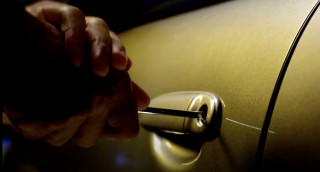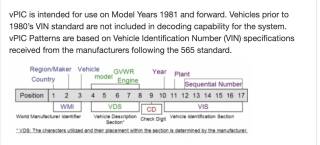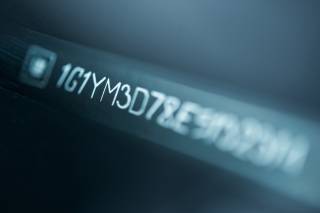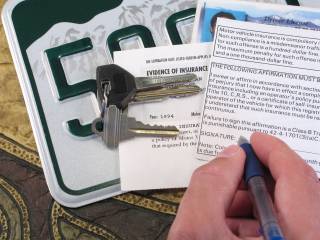September 26, 2023
The acronym VIN stands for vehicle identification number, a unique 17-digit alpha and numeric string of characters for each and every vehicle manufactured or imported since the 1981 model year. The U.S. Department of Transportation mandates that every automaker stamp a VIN on every car off the assembly line or imported into the U.S. to track vehicle registrations, recalls, warranty claims, thefts and insurance coverage.
A VIN acts like a car’s unique social security number, but it’s used for most other vehicles that fall under the purview of government oversight and classified as a motor vehicle, such as passenger vehicles, trucks, buses, trailers, low-speed vehicles, restomods, one-offs, modified vehicles, motorcycles, and more. The NHTSA’s definition of a motor vehicle is “a vehicle that is driven or drawn by mechanical power and manufactured primarily for use on public streets, roads, and highways.” But side-by-sides, ATVs, UTVs, and other off-road fun vehicles have VINs as well.
Each character in the VIN has a specific purpose.
What does each digit in the VIN mean?
1st character – identifies the country of manufacture and assembly. For example, U.S. (1 or 4), Canada (2), Mexico (3), Japan (J), Korea (K), England (S), Germany (W), Italy (Z). If there are parts manufactured in Mexico, for example, but assembled in the U.S., then the country code would be the U.S.
2nd – identifies the manufacturer. For example, Audi (A), BMW (B), General Motors (G), Ford (F), Honda (H), Mercedes-Benz (D), Nissan (N), Toyota (T), Volkswagen (V)
3rd – identifies the vehicle type or manufacturing division
4th through 8th – identifies vehicle attributes, such as body style and engine type
9th – called the “check digit,” the ninth character uniquely identifies the vehicle, ensuring that no two cars within a 30-year period have the same VIN
10th – identifies the model year
11th – identifies the assembly plant
12th through 17th – identifies the sequence of the vehicle off the assembly line, with the last four characters always numeric
Where can I find the VIN?
The VIN appears in several places, both on the vehicle itself and in official documentation when registering vehicle ownership. Like a social security number, it’s important to protect the VIN to prevent fraud or make it easier to steal the car.
Where is the VIN located in the car?
Auto manufacturers stamp the VIN in several different places on a vehicle.
- The most visible one is near the driver’s side cowl, inside on the dash by the front windshield, located on the driver side interior dash by the windshield. It’s usually on a stamped plate or label, but some new car sellers and aftermarket shops offer to etch it into the windshield itself to prevent thieves from restamping VINs on stolen cars.
- Another location is on the driver’s side door jamb on the Federal Safety Certification Label.
- A VIN may be stamped on the front or top of the engine block, the engine frame, and many other hidden parts of the vehicle.
- Consumers can also opt to have their VIN permanently etched into various parts of the car, a practice encouraged by insurance companies to help discourage theft and selling of car parts.
Where is the VIN located in the paperwork?
The VIN typically appears in four places related to ownership, registration, and insurance of the car.
- It’s always on the vehicle title, typically near the top of the title, but it can vary based on the state.
- It also appears on your vehicle registration card, which is typically kept in the glovebox with the insurance card and owner’s manual.
- The VIN also comes in the printed owner’s manual.
- The insurance card also shows the VIN.
What can I do with my VIN?
The VIN lets you check the vehicle history, to seek out safety recalls, to register the car with the state and to insure it, to report or check for stolen cars, as well as other information.
Check the VIN decoder for vehicle info
Tracking a VIN online lets you search the vehicle’s country of origin, manufacturing plant, and other historical data as provided by the decoder mentioned above. The NHTSA’s VIN decoder portal provides the information supplied by the manufacturer to the government.
Research the VIN before buying a used car
When considering a used car, check the VIN of the desired vehicle on national online databases such as Carfax that shows info supplied by DMVs, insurance claims, police and fire departments, auto auctions, collision repair places, and more. It can certify the odometer reading, ascertain if an insurance company has deemed the car a total loss through “salvage” or “flood” titles, or any natural disaster occurrence.
Use the VIN to track safety recalls or known issues
Entering a VIN on the NHTSA.gov recall site will show what recalls have been made on a car. It also shows complaints lodged by owners for a specific make, model, and year, so you can see what kind of problems to expect with a similar model year vehicle.
Apply the VIN to car insurance policies
You need to file a VIN to get car insurance. Insurance companies use VINs to assess the car’s worth, and provide a quote specific to that car. You can still get a general insurance quote on the type of car and type of driver without the VIN, but to lock down the policy, you’ll need the VIN.
Mechanics and shops use the VIN for repairs and parts
Body shops and repair services use the VIN to identify and order replacement parts.

How do I use the VIN to protect against vehicle theft?
Car thieves can troll parking lots or cars parked on the street, copy the VIN, create counterfeit tags, then steal a similar car and use the fake tag on it to sell the “clone” in another state, typically with false documentation, according to the National Insurance Crime Bureau. The NICB offers a free VINCheck service that shows if a vehicle has been reported as stolen but not recovered, or is a salvage or flood vehicle that shouldn’t be on the secondary market.


